
The Feudal System
The term “feudal” first began to be used by historians around the 16 th or 17 th century, and then only in its Latin form. So “feudal” and “feudalism” are relatively modern terms not known to the people of the 12 th century. Some historians are now calling into question whether there was ever a feudal “system”. The practices described here, did happen in Norman times so I will continue to call them collectively as “feudalism” or the “feudal system”.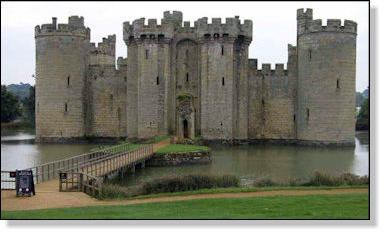
Who Were the Normans?
Originally, the Normans were Norse (Vikings) who invaded, settled and gave their name to the area known as the Duchy of Normandy. At the beginning of the 10 th century, The French King, Charles the Simple, gave Rollo, the Viking chief, land in order to stop further attacks on French territory. The Normans (‘North men’) assimilated into continental ways, becoming Christians and adopting the feudal economy.
Feudalism was in common practice across Europe from the 9
th
century onwards, Gaels, Picts,
Britons, Angles, and Saxons had their own systems, similar to each other in many ways, but all
different from the feudal system. The Norse were different again (see Norse Life).
Essentially, the feudal system was based around the concept that the king own all the land in his
domain. That land could be parcelled out by the king in return for payments in cash and services to
the king. The services could be religious or secular. Those in receipt of land (a fiefdom) from the
king were deemed lords, of various ranks. The lords could in
turn subdivide their holdings into manors, giving them to those
who swore allegiance to the lord.
At each level, land was parcelled out as a heritable holding, in
return for allegiance and services. The recipient of land was
termed a ‘vassal’, even at the highest level, and allegiance was sworn in a religious ceremony,
which made the relationship very serious indeed.
At the bottom of this pyramid were the Serfs. They were not vassals as they did not swear
allegiance; their loyalty was taken for granted Indeed, they were regarded as part of the land owned
by the lord. They could be punished for not honouring their obligations as tenants.
Vassal
A vassal is a person who has entered into a mutual obligation with an overlord or monarch, including military support and mutual protection, in exchange for privileges such as the grant of land held as a fiefdom. The vassal would pay “homage” to his overlord at a formal religious ceremony. This commitment was carried upward to include his overlord’s overlord, through to the monarch. In return for this loyalty, the overlord granted rights such as the use of land or other form of support. After the act of homage in which the vassal became his overlord’s “man”, the vassal then swore “fealty” in which he committed himself to providing services or other provisions as required by the overlord. The oaths of homage (from the French word for “man”) and fealty were taken as part of a religious ceremony, over a Bible or relic of a saint. Thus they were taken before God and carried great weight in the minds of all participants.Fief/Manor
Holding a fief did not confer what we would now think of as ownership of the freehold of a property on the vassal, only the usage rights. This enabled an overlord (at any level) to withdraw those rights should the vassal have, in some way, not honoured his obligations to his overlord. A fiefdom was normally awarded for the lifetime of the vassal (assuming they committed no crime in the eyes of the overlord). By the 12 th century a fiefdom could be passed on to descendants of the deceased vassal, provided that the receiving lord repeated the oaths taken by his predecessor.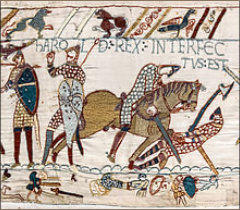
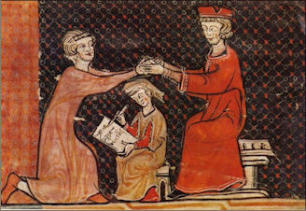
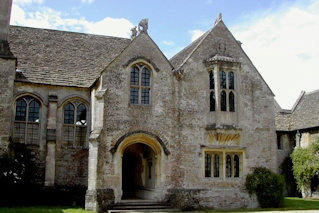



The Feudal System
The term “feudal” first began to be used by historians around the 16 th or 17 th century, and then only in its Latin form. So “feudal” and “feudalism” are relatively modern terms not known to the people of the 12 th century. Some historians are now calling into question whether there was ever a feudal “system”. The practices described here, did happen in Norman times so I will continue to call them collectively as “feudalism” or the “feudal system”.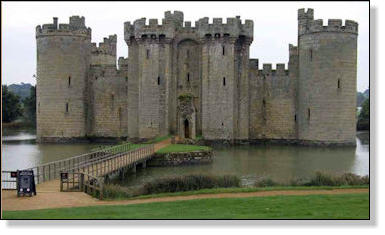
Who Were the Normans?
Originally, the Normans were Norse (Vikings) who invaded, settled and gave their name to the area known as the Duchy of Normandy. At the beginning of the 10 th century, The French King, Charles the Simple, gave Rollo, the Viking chief, land in order to stop further attacks on French territory. The Normans (‘North men’) assimilated into continental ways, becoming Christians and adopting the feudal economy.
Feudalism was in common
practice across Europe from the
9
th
century onwards, Gaels,
Picts, Britons, Angles, and
Saxons had their own systems,
similar to each other in many
ways, but all different from the
feudal system. The Norse were
different again (see Norse Life).
Essentially, the feudal system was based around the concept
that the king own all the land in his domain. That land could be
parcelled out by the king in return for payments in cash and
services to the king. The services could be religious or secular.
Those in receipt of land (a
fiefdom) from the king
were deemed lords, of
various ranks. The lords
could in turn subdivide
their holdings into manors,
giving them to those who
swore allegiance to the
lord.
At each level, land was parcelled out as a heritable holding, in
return for allegiance and services. The recipient of land was
termed a ‘vassal’, even at the highest level, and allegiance was
sworn in a religious ceremony, which made the relationship
very serious indeed.
At the bottom of this pyramid were the Serfs. They were not
vassals as they did not swear allegiance; their loyalty was
taken for granted Indeed, they were regarded as part of the
land owned by the lord. They could be punished for not
honouring their obligations as tenants.
Vassal
A vassal is a person who has entered into a mutual obligation with an overlord or monarch, including military support and mutual protection, in exchange for privileges such as the grant of land held as a fiefdom. The vassal would pay “homage” to his overlord at a formal religious ceremony. This commitment was carried upward to include his overlord’s overlord, through to the monarch. In return for this loyalty, the overlord granted rights such as the use of land or other form of support. After the act of homage in which the vassal became his overlord’s “man”, the vassal then swore “fealty” in which he committed himself to providing services or other provisions as required by the overlord. The oaths of homage (from the French word for “man”) and fealty were taken as part of a religious ceremony, over a Bible or relic of a saint. Thus they were taken before God and carried great weight in the minds of all participants.Fief/Manor
Holding a fief did not confer what we would now think of as ownership of the freehold of a property on the vassal, only the usage rights. This enabled an overlord (at any level) to withdraw those rights should the vassal have, in some way, not honoured his obligations to his overlord. A fiefdom was normally awarded for the lifetime of the vassal (assuming they committed no crime in the eyes of the overlord). By the 12 th century a fiefdom could be passed on to descendants of the deceased vassal, provided that the receiving lord repeated the oaths taken by his predecessor.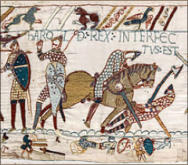
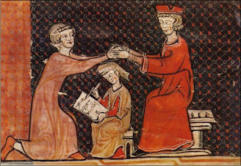
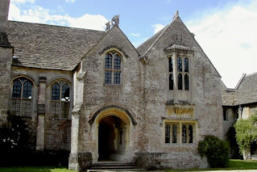




Walter Jardine
About A Wolf in His Belly
The Normans
Feudalism




















